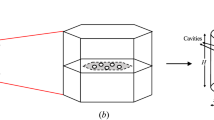Abstract
In this paper we present the methods of determination and the stress obtained at the periphery of a cold expanded hole in a 2024-T3 Alclad aluminum alloy sheet. The measurements in the aluminum clad were performed by the sin2Ψ method, taking experimental precautions to deal with the texture effects. In the core aluminum a special method had to be implemented to determine the stress values in a direction not accessible to the X-ray diffraction. The strains were measured in sample orientations selected according to the texture characteristics and stress factorsF ij were used to calculate the stress tensor. TheF ij values were determined assuming a quasi-isotropic material behavior, after concluding that the stress results were not significantly affected by factors calculated for textured material. The residual stress profile, both in the clad and in the sheet, shows a nearly axisymmetric stress state. Compressive stresses were observed near the periphery of the hole, with values that are higher on the exit than on the entrance face. Residual stresses were also higher in the hoop direction than in the radial direction. They decreased with the radial distance to the hole and affected the previous stress state over a distance of 6 mm. The plastic deformation induced by the cold expansion is well evidenced by the FWHM values, which in the affected zone decrease with increasing distance from the hole edge.
Similar content being viewed by others
References
O'Brien, E., “Residual Stress — ‘Friend’ and ‘Foe’. A Civil Aircraft Perspective,”Proceedings of the 6th International Conference on Residual Stresses (ICRS6). Oxford, UK, 10–12 July, Vol.1, IOM Communications,13–21 (2000).
Ozdemir, A.T., Wang, D.Q., and Edwards, L., “Measurement of the 3D Residual Stress Distribution at Split Sleeve Cold Expanded Holes,” Proceedings of the 4th International Conference on Residual Stresses (ICRS4), Baltimore, MD, 8–10 June, Society for Experimental Mechanics, 1144–1153 (1994).
Priest, M., Poussard, C.G., Pavier, M.J., and Smith, D.J., “An Assessment of Measured and Predicted Residual Stresses Around Cold Worked Holes in Al2024,” Proceedings of the 4th International Conference on Residual Stresses (ICRS4), Baltimore, MD. 8–10 June, Society for Experimental Mechanics, 324–332 (1994).
Stefanescu, D., Edwards, L., andFitzptrick, M.E., “X-ray Diffraction Measurement of the Residual Stresses Surrounding a Cold Expanded Hole,”Materials Science Forum,404–407,185–190 (2002).
Stefanescu, D., Dutta, M., Wang, D.Q., Edwards, L., andFitzpatrick, M.E., “The Effect of High Compressive Loading on Residual Stresses and Fatigue Crack Growth at Cold Expanded Holes,”Journal of Strain Analysis and Engineering Design,38(5),419–427 (2003).
Hauk, V., editor, Structural and Residual Stress Analysis by Nondestructive Methods, Elsevier Science, Amsterdam (1997).
FTI, Cold Expansion Holes Using the Standard Split Slceve System and Countersink Cold Expansion,”Fatigue Technology Inc., 150 Andover Park West, Seattle, WA (2002).
Dahms, M. andBunge, H.J., “The Iterative Series-expansion Method for Quantitative Texture Analysis. I — General Outline,”Journal of Applied Crystallography,22,439–447 (1989).
Sprauel, J.M., François, M., andBarral, M., “Calculation of X-ray Elastic Constants on Textured Materials Using Kröner Model,”Proceedings of the 2nd International Conference on Residual Stresses (ICRS2), Nancy, France, 23–25 November, Elsevier Applied Science, London, 172–177 (1988).
Kocks, U.F., Tomé, C.N., andWenk, H.R., editors, Texture and Anisotropy. Preferred Orientations in Polycrystals and Their Effect on Materials properties, Cambridge University Press, Cambridge (1998).
Marques, M.J., Dias, A.M., Gergaud, P., andLebrun, J.L., “A Methodology Development for the Study of Near Surface Gradients,”Materials Science Engineering A,287,78–86 (2000).
Matos, P., Moreira, P., Pina, J., Dias, A.M., and de Castro, P.M.S.T., “Residual Stresses Around an Expanded Hole in an Aluminum Clad Sheet,” Proceedings of the 7th International Conference on Residual Stress (ICRS7), Xi'an, China, 14–16 June 2004, in the Proceedings of ICRS7, CD ROM (2004).
Cook, R. andHoldway, P., “Residual Stresses Induced by Hole Cold Expansion,”Computer Methods and Experimental Measurements for Surface Treatment Effects, C.A. Brebbia andM.H. Aliabadi, editors, Wessex Institute of Technology, UK, 91–101 (1993).
Garcia-Granada, A.A., Lacarac, V.D., Holdway, P., Smith, D.J., andPavier, M.J., “Creep Relaxation of Residual Stresses Around Cold Expanded Holes,”Journal of Engineering Materials Technology,123,125–131 (2001).
Author information
Authors and Affiliations
Rights and permissions
About this article
Cite this article
Pina, J.C.P., Dias, A.M., de Matos, P.F.P. et al. Residual stress analysis near a cold expanded hole in a textured alclad sheet using X-ray diffraction. Experimental Mechanics 45, 83–88 (2005). https://doi.org/10.1007/BF02428993
Received:
Accepted:
Issue Date:
DOI: https://doi.org/10.1007/BF02428993




